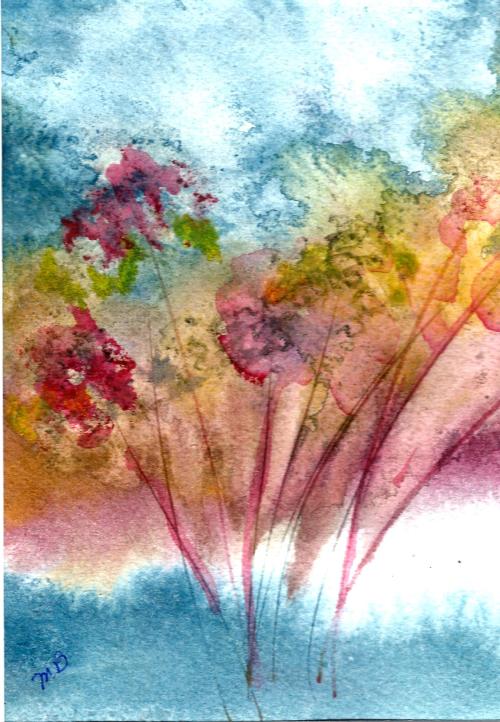
Back after a long hiatus—time enough for a new hip, a lazy summer, and plenty of physical therapy. But artmaking was a huge part of the therapy. Standing is easier for me than sitting, no matter what. And regardless of whatever this body is up to, if I can create something I am a happy woman!
Above is a 20″ x 24″ painting that should be titled, “Love/Hate”. Being a bit vociferous about opinions, I have long claimed that I hate acrylics. They have seemed so fake appearing and stupid to me—stubborn, inflexible, hard to shove around, incapable of producing those wonderful watercolor “cauliflowers”, and totally lacking in subtlety. Especially when gouache can do the job of building depth and texture, although gouache needs to be preserved with glass or an acrylic (there is that word!) fixative–and acrylic paint needs only itself for permanence.
Then, amazingly, I came across books and a DVD by a new-to-me British artist: Soraya French who has painted in most all media, but absolutely LOVES acrylics. The material struck me as somewhere out there, to begin with. But after reading, re-reading, viewing, and reviewing, “somewhere out there” closed in on me. Soraya French has pried open my closed mind.
I recently completed “Love/Hate” and still was not sure which it was: love or hate. The piece went through many mutations, layer upon layer, changes of theme and subject matter, as well as variations of color dominance. But hey, that’s acrylics: layer upon layer.
While the painting was at its final stage of dampness, I truly thought it was tacky—like something one might win at the county fair for knocking off a row of mechanical ducks. But suddenly the piece was dry and it took on a whole new life. I kept staring at it, as it penetrated my psyche. Hate disappeared, and Love became at least a “Like”. The painting is now hanging in our dining room.
Love/Hate has a new name. My original idea was to suggest autumn foliage. The foliage changed to bare branches for winter, sailboat masts on a stormy sea, finally returning to the tree motif—but with an attitude more like spring than autumn. So the new title is “An Autumn That Looks Like Spring”. Fitting, as we have had a gloriously warm/hot September, and today is once again in the high 70s.
For me, trees are like lilies and haystacks to Monet—although repetition is where the comparison ends between Claude and me. Rather ridiculous to mention the two of us in the same sentence. But I am as genuinely obsessed with trees, as Monet was smitten with his favorite subjects.
Over the summer and my surgery-recovery-period I did some more trees, with a focus on texture and application of mixed media along with watercolors and gouache: soft pastels, hard pastels, oil pastels, India ink, Derwent Inktense Sticks, and water soluble crayons (all of artist quality as anything less would prove disappointing). Here is some of that harvest of trees:



In closing, I urge you to check out Soraya French’s website. Another inspiring British lady—who has re-opened the doors to individuality, personality, and freedom in art.
Whereas from around the turn of the 19th/20th century right up to a couple of decades ago, freedom of expression in art was “trendy” (almost a given), in recent years there has been a definite swing back to photo-realism: creating recognizable art such as “The Old Village Bridge”, “Apple Farm”, “Country Church”, or realistic city scenes.
In our Wisconsin neighborhood, a familiar scene is the church with three spires high on a rural hill. The site is called, “Holy Hill”. It has been painted realistically more times than I can imagine, and a rendering of Holy Hill is recognized by anyone who has been around here for any time at all.
Beautiful! Such art requires great skill, and deserves its place of respect. But it is not, generally speaking, the art I desire to have much of on my walls. More and more, I am drawn to mystery, unanswered questions, and the energy of abstraction–or semi-abstraction with a touch of realism, all with a focus on being as beautiful as possible.
In the arts, I see no value in trying to reproduce the ugliness of much of the world. Art is a precious commodity, a timeless gift in keeping with great music and poetry—bestowed upon us to lift our souls. Yes, we can and should portray all of life in terms of great sadness and poignancy as well as great joy; but the means of portrayal can be beautiful and the message behind the means, one of hope and anticipation of a better world.
Isn’t that why our Creator God has allowed us to reflect a token of His creativity, by making things with the gifts and resources He has provided for us—that we might in some tiny way attempt to fashion a better world?
Margaret L. Been — October 3, 2018












 Meanwhile: Happy New Year to you from Joe, Margaret, and the sweetest corgi imaginable—Dylan Been.
Meanwhile: Happy New Year to you from Joe, Margaret, and the sweetest corgi imaginable—Dylan Been.







